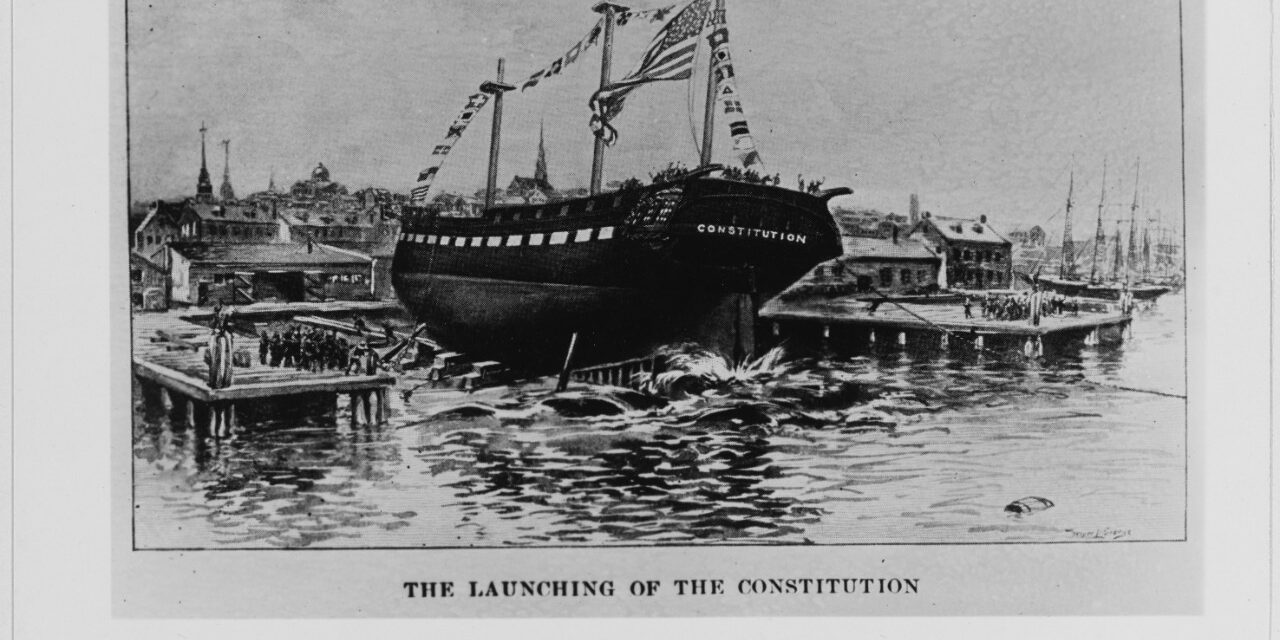 On October 21, 1797, the USS Constitution was launched in Boston Harbor after two previous failed attempts. The Naval Armament Act, signed by George Washington on March 27, 1794, authorized six frigates. She was the third to be completed, preceded by United States and Constellation. The other three were Congress, Chesapeake, and President. Essentially this was the foundation of the United States Navy. Of these six, only the USS Constitution survives and is still commissioned!
On October 21, 1797, the USS Constitution was launched in Boston Harbor after two previous failed attempts. The Naval Armament Act, signed by George Washington on March 27, 1794, authorized six frigates. She was the third to be completed, preceded by United States and Constellation. The other three were Congress, Chesapeake, and President. Essentially this was the foundation of the United States Navy. Of these six, only the USS Constitution survives and is still commissioned!
The United States Constitution forbids the funding of a “standing army” (Art. I, S. 8, cl. 12-13). Thus, the early Congress did not initially authorize ships of war. However, after the American Revolution ended in 1783, merchants sailing to Europe were no longer protected by England or France. As a result, the “Barbary Pirate” nations of Morocco, Algiers, Tunis, and Tripoli openly attacked and enslaved Americans. Traditionally, European nations, and subsequently the United States, paid a tribute (tax) to these Muslim countries, or a ransom for enslaved citizens, to “purchase” peace when entering the Mediterranean Sea. Though this was repugnant, especially to the principles undergirding our U.S. Constitution, we were powerless to enforce peace in the face of terrorism.
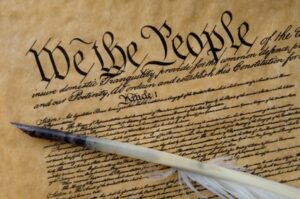 Though treaties had been attempted, they were not successful at resolving the situation. It is important to recognize that the original understanding of the Constitution was that Congress, and specifically the Senate, established foreign policy, and the Executive carried it out. Jefferson, knowing that yielding to ransom demands encourages more of the same, wrote, “It rests with Congress to decide between war, tribute, and ransom, as the means of re-establishing our Mediterranean commerce… they will enable the Executive to engage….”
Though treaties had been attempted, they were not successful at resolving the situation. It is important to recognize that the original understanding of the Constitution was that Congress, and specifically the Senate, established foreign policy, and the Executive carried it out. Jefferson, knowing that yielding to ransom demands encourages more of the same, wrote, “It rests with Congress to decide between war, tribute, and ransom, as the means of re-establishing our Mediterranean commerce… they will enable the Executive to engage….”
It was these challenges that inspired Congress to establish the United States Navy. How could we repel terrorist attacks without the military power to do so? “The act of March 27, 1794 authorized six ships but also provided that the program should be dropped if ‘a peace shall take place between the United States and the Regency of Algiers.’ … When a peace treaty with Algiers was eventually concluded, Congress reduced the shipbuilding program to three frigates that were launched in 1797.” Due to continued pressures from the terrorist attacks, the other three ships were eventually launched as well.
It is understandable that the USS Constitution is the most famous of all six frigates. This is because of her storied history. Her first voyage was from Boston to the Caribbean in 1798. It patrolled the Atlantic Coast of the United States. This patrolling continued during the Quasi-War with France from 1798-1801. It was called a Quasi-War since no official declaration was given, but Congress issued 24 authorizations in a one-year period in defense of American shipping. The Supreme Court, in 1800, affirmed that “Congress is empowered to declare a general war, or Congress may wage a limited war.” What it cannot do is conduct a war merely at the discretion of the Executive.
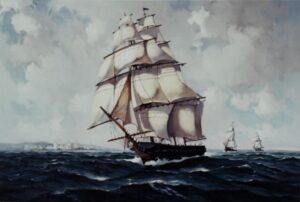 It was during the Barbary Pirate wars in the Caribbean that the USS Constitution became famous abroad. After the U.S. refused to pay tribute to Tripoli, the Pasha declared war on the U.S. in 1801. In September of 1803, Commodore Preble arrived aboard the USS Constitution and immediately made his presence felt. Despite the capture and destruction of the USS Philadelphia, Preble enforced the blockade and eventually the surrender of Tripoli.
It was during the Barbary Pirate wars in the Caribbean that the USS Constitution became famous abroad. After the U.S. refused to pay tribute to Tripoli, the Pasha declared war on the U.S. in 1801. In September of 1803, Commodore Preble arrived aboard the USS Constitution and immediately made his presence felt. Despite the capture and destruction of the USS Philadelphia, Preble enforced the blockade and eventually the surrender of Tripoli.
After war was declared with Great Britain in June of 1812, the USS Constitution was resupplied and sent to New York. Five British warships were setting up a blockade of New York Harbor. Captain Isaac Hull, after encountering HMS Guerriere and four other ships, outmaneuvered and outran all five from July 16 to 19, finally docking back in Boston! In praise of his crew, Captain Hull ended his personal report with these words about them: “I cannot… close… without expressing to you the confidence I have in them, and assuring you that their conduct whilst under the Guns of the Enemy was such as might have been expected from American Officers and Seamen.” Character and courage were a part of the fabric of America in the 19th century and set the gold standard for future veterans as well!
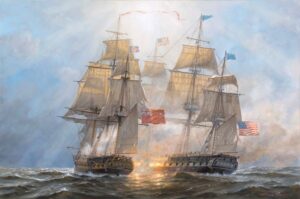 But it would be the USS Constitution’s encounter with HMS Guerriere weeks later that would give her the nickname “Old Ironsides.” On August 19 the two met for battle. Captain Isaac Hull wrote in his report: “…We commenced a very heavy fire from all of our Guns, loaded with round, and grape, which done great Execution, so much so that in less than fifteen minutes… it (was) very difficult for them to manager her. At this time the Constitution had received but little damage….” It was reported that in this battle, “cannonballs seemed to bounce off its thick wooden sides, which were comprised of three layers of oak, and all in the water.” Thus her nickname became “Old Ironsides!”
But it would be the USS Constitution’s encounter with HMS Guerriere weeks later that would give her the nickname “Old Ironsides.” On August 19 the two met for battle. Captain Isaac Hull wrote in his report: “…We commenced a very heavy fire from all of our Guns, loaded with round, and grape, which done great Execution, so much so that in less than fifteen minutes… it (was) very difficult for them to manager her. At this time the Constitution had received but little damage….” It was reported that in this battle, “cannonballs seemed to bounce off its thick wooden sides, which were comprised of three layers of oak, and all in the water.” Thus her nickname became “Old Ironsides!”
USS Constitution continued its career with a defeat of HMS Java under Captain Bainbridge’s command on December 29, 1812 off the coast of Brazil. After this battle, the Royal Navy changed its tactics so that no longer would they allow their ships to engage American frigates alone. After a period in dry dock, USS Constitution defeated two British men-of-war, HMS Cyane and HMS Levant. Both vessels did not engage USS Constitution alone, but both struck their colors on February 20, 1815. The Treaty of Ghent, ending the War of 1812, had been signed three days earlier, but neither side knew this at the time.
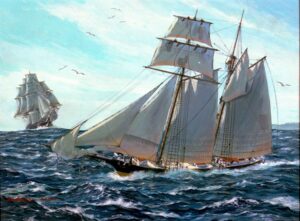 After she served in the Mediterranean (1821-1828), naval commissioners thought of scrapping her, but Oliver Wendell Holmes’ 1830 poem, “Old Ironsides,” inspired a wave of public protest that restored her to sea again. It is providential to note that the USS Constitution, named after the longest-lasting constitutional document protecting liberty in the world, seized as her last prize the H.N. Gambrill of New York off the shores of Africa in 1853. It was a slave ship operating in violation of the joint treaty between the U.S. and England.
After she served in the Mediterranean (1821-1828), naval commissioners thought of scrapping her, but Oliver Wendell Holmes’ 1830 poem, “Old Ironsides,” inspired a wave of public protest that restored her to sea again. It is providential to note that the USS Constitution, named after the longest-lasting constitutional document protecting liberty in the world, seized as her last prize the H.N. Gambrill of New York off the shores of Africa in 1853. It was a slave ship operating in violation of the joint treaty between the U.S. and England.
Thus, the USS Constitution’s final prize was defending the liberty promised by our Declaration that “all men are created equal” and protecting it through our Constitution. The legacy of the USS Constitution is that “‘Old Ironsides’ has a perfect battle record, having never been defeated or boarded.” May Americans today remember those who paid the ultimate price and rescue our recipe of liberty that some have determined ought to be scrapped. Let us defend and preserve her for generations to come!

